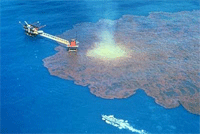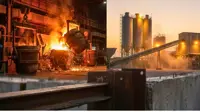Halliburton to admit it destroyed evidence on Gulf of Mexico disaster
26 Jul 2013
Halliburton, the world's second-largest oil field services company behind Schlumberger, has agreed to plead guilty of destroying critical evidence related to the 2010 Gulf of Mexico oil spill.
 The plea agreement arrived yesterday with the US Justice Department (DoJ), comes after the Houston-based company had initially aggressively denied that it was in any way responsible for the oil spill, the largest in US history.
The plea agreement arrived yesterday with the US Justice Department (DoJ), comes after the Houston-based company had initially aggressively denied that it was in any way responsible for the oil spill, the largest in US history.
On 20 April 2010, the Deepwater Horizon rig belonging to Transocean and leased to BP caught fire and exploded killing 11 people and led to more than 200 million gallons of oil spewing from BP's Macondo well that was cemented by Halliburton and located a mile under the deep waters of the Gulf of Mexico.
Although BP, as the operator of the well, had then taken moral responsibility for the disaster (See: BP to plead guilty to 14 criminal counts over Gulf of Mexico disaster), all its partners and contractors refused to accept their share of responsibility and tried to dump the entire blame on BP in a bid to avoid expensive lawsuits.http://www.domain-b.com/companies/companies_b/British_Petroleum/20121116_criminal_counts.html
London-based BP had accused Halliburton of destroying evidence and asked it to pay for damages, but both Halliburton and Transocean' said that whatever they did, was at the direction of BP and were "fully indemnified by BP."
As part of the agreement with the DoJ, Halliburton will pay the maximum allowable fine of $200,000 and will be subject to three years of probation.
It will also continue to cooperate with the government in its criminal investigation.
Separately, Halliburton made a voluntary contribution of $55 million to the National Fish and Wildlife Foundation, which was not a condition on the court's acceptance of its plea agreement.
According to court documents, following the blowout, Halliburton conducted its own review of various technical aspects of the well's design and construction and established an internal working group to examine the Macondo well blowout, including whether the number of centralizers used on the final production casing could have contributed to the blowout.
Prior to the blowout, Halliburton had recommended to BP the use of 21 centralisers in the Macondo well, but BP opted to use six instead.
After running two computer simulations of the final cementing job on the Macondo well using Halliburton's Displace 3D simulation program to compare the impact of using six versus 21 centralisers, the simulations indicated that there was little difference between using six and 21 centralisers.
Halliburton's program manager was directed to, and did, destroy these results.
Halliburton's cementing technology director asked another, more experienced, employee to run simulations again comparing six versus 21 centralisers. The employee reached the same conclusion and was then directed to ''get rid of'' the simulations.
Despite these two independent results, Halliburton continued to claim that BP was neglectful and did not follow its advice.
(Also see: US panel blames BP, Transocean and Halliburton for Gulf of Mexico oil spill)






















